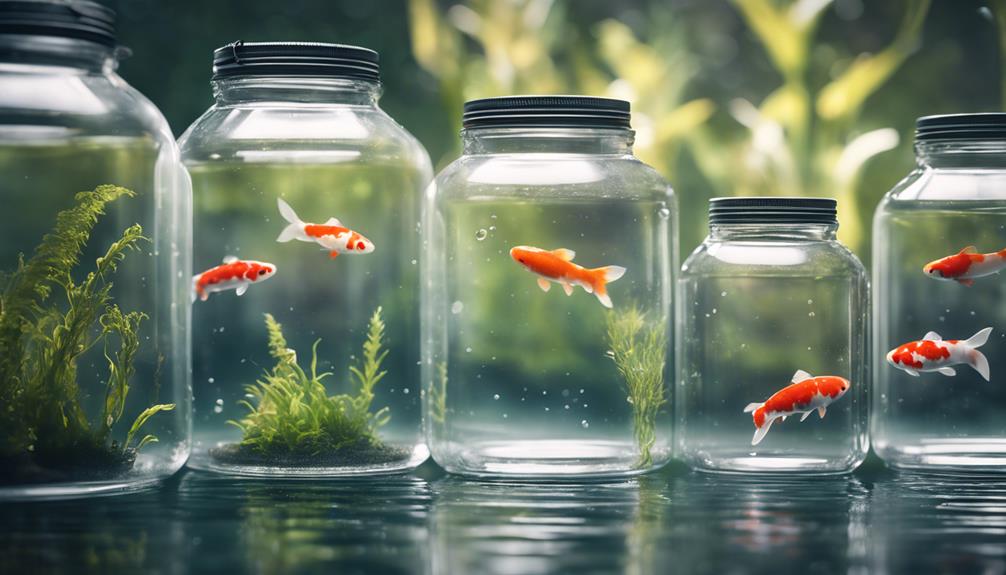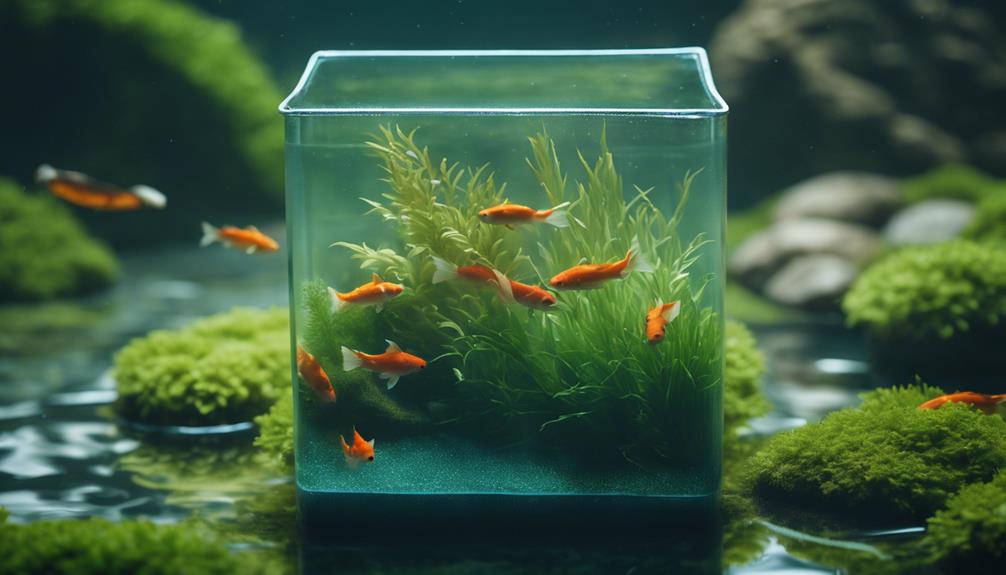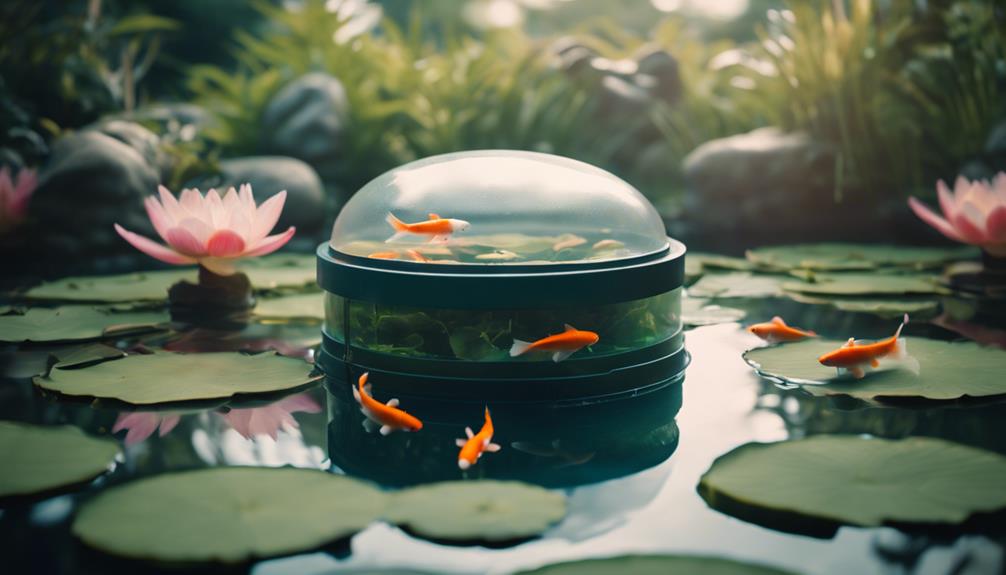You're about to create the perfect container for koi spawn. First, guarantee ideal water conditions: 65°F-70°F temperature, 6.5-8.5 pH, and 5-15 dGH water hardness. Next, equip your tank with a reliable filtration system, heater, aeration, and a spawning medium. A larger container provides a more stable water environment, but be mindful of stocking density and maintenance ease. Effective filtration systems, secure design, and a peaceful environment are also vital. By getting these elements right, you'll set your koi spawn up for success. Now, discover the intricacies of creating a thriving environment that fosters healthy growth and development.
Table of Contents
Key Takeaways
- A perfect container for koi spawn should have a water volume that provides a stable environment and supports the growth of fry.
- The container size should balance filtration efficiency, breeding environment, and ease of maintenance to prevent overcrowding and stress.
- A secure design is essential to prevent fragile fry from jumping out or getting sucked into pumps or filters.
- The container should have a large enough capacity, at least 1000 gallons, to provide a stable environment for growing fry.
- A perfect container should also have an escape-proof design to prevent fry from escaping or getting injured.
Ideal Water Conditions
When breeding koi, you'll need to carefully manage the water conditions to trigger spawning, as the ideal environment is essential for successful reproduction.
To create a perfect environment, you'll want to maintain a water temperature between 65°F and 70°F, with a gradual increase in temperature triggering the spawning process. Additionally, you'll need to monitor water pH, keeping it between 6.5 and 8.5, as koi are sensitive to fluctuations and extreme values can cause stress and even death.
The water hardness level should be between 5-15 dGH, as koi thrive in soft to moderately hard water, and extreme hardness can lead to osmoregulatory issues.
Regular water changes are imperative to maintain water quality and prevent the buildup of toxins. You should aim to perform water changes that replace around 10-20% of the tank's water weekly. This will help remove waste products and maintain a healthy environment for your koi.
Essential Equipment Requirements
To successfully breed koi, you'll need to equip your breeding tank with specific gear that fosters a healthy and conducive environment for spawning.
A reliable filtration system is essential for maintaining superior water quality, which is pivotal for koi breeding. A high-quality filter will remove waste and excess nutrients, preventing ammonia and nitrite buildup that can harm your koi.
You'll also need a heater to maintain a consistent water temperature between 65°F and 75°F, ideal for breeding koi.
Adequate aeration is also indispensable, as it promotes healthy gas exchange and prevents oxygen depletion.
A spawning medium, such as a breeding grate or spawning brush, is necessary to provide a surface for the eggs to adhere to.
Additionally, a net or egg collector will help you collect the eggs safely and efficiently.
Perfect Container Size Matters

Key container size plays a pivotal role in koi spawn development, as it directly impacts water volume, filtration efficiency, and the overall breeding environment. You want to guarantee your container is large enough to support the growth of your koi spawn, while also being manageable for maintenance and upkeep.
When it comes to choosing the perfect container size, consider the following factors:
- Water volume: A larger container will provide a more stable water environment, which is essential for koi spawn development.
- Stocking density: A smaller container may lead to overcrowding, which can increase stress and disease risk among your koi spawn.
- Ease of maintenance: A container that's too large can be difficult to clean and maintain, while one that's too small may require frequent water changes.
Effective Filtration Systems Needed
You'll need to implement an effective filtration system capable of handling the increased ammonia and nitrate production of your koi spawn to maintain ideal water quality and prevent disease outbreaks.
A reliable pond filter is vital in removing waste and excess nutrients that can harm your fish. Consider setting up a recirculation system to reuse water from the main pond, reducing waste and conserving water.
Maintaining a balance in your filtration system is vital, as over-cleaning the filter media can disrupt the ecosystem and harm beneficial bacteria that break down waste.
Regular water changes of up to 10% daily are also recommended to prevent water quality issues.
By incorporating live plants in your grow pond, you'll not only provide shelter and food for the fry but also help maintain water quality by absorbing excess nutrients.
A well-designed filtration system will guarantee your koi spawn thrive in a healthy environment, and you can enjoy watching them grow and develop.
Safe and Healthy Environment

While a reliable filtration system sets the stage for a healthy environment, creating a safe and healthy space for your koi spawn to thrive is equally important, starting with a carefully designed container that addresses their unique needs.
You want to guarantee your baby koi grow into healthy fish, and that requires a secure and peaceful environment.
A secure and escape-proof design is necessary to prevent the fragile fry from jumping out or getting sucked into pumps or filters.
Live plants or plants with large leaves should be included to provide shelter and food for the newly hatched fry, as well as to help maintain good water quality.
A large enough capacity (at least 1000 gallons) is required to provide a stable environment for the growing fry.
Frequently Asked Questions
What Are the Conditions for Koi to Spawn?
You'll increase koi spawning chances by providing ideal conditions: specific spawning triggers like plants or artificial substrates, excellent water quality with stable pH and temperature, and a balanced sex ratio with at least two males per female.
How to Encourage Koi Spawning?
You'll be amazed that koi can produce up to 100,000 eggs per spawn! To encourage koi spawning, focus on ideal water quality, stimulate spawning triggers like water changes and temperature fluctuations, and provide food supplements rich in protein and omega-3 fatty acids.
Is 1000 Gallons Enough for Koi?
You're wondering if 1000 gallons is enough for koi, but consider tank size limitations – with water volume calculations, you'll see overstocking risks arise, so it's vital to calculate 1 inch of fish per gallon to guarantee a healthy environment.
How Long Does Koi Spawning Last?
As you set out on this koi-keeping journey, you'll find that spawning frequency varies, with breeding cycles typically lasting 2-3 days, and mating duration averaging 1-2 hours, with some pairs taking up to 4 hours to complete the ritual.
Conclusion
You've carefully crafted the perfect environment for your koi spawn, and now it's time to bring it all together.
Your container is a delicate orchestra, with each component working in harmony to create a symphony of life.
Just as a maestro expertly conducts his musicians, you've skillfully balanced ideal water conditions, essential equipment, perfect container size, and effective filtration systems to create a safe and healthy haven for your precious koi to thrive.

